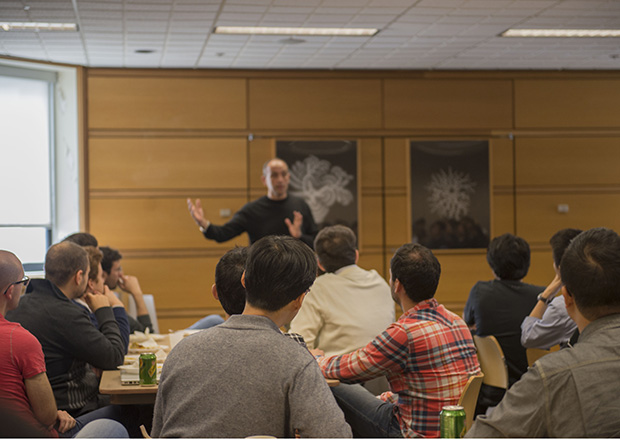Clik here to view.
 Image may be NSFW.
Image may be NSFW.Clik here to view.
 Image may be NSFW.
Image may be NSFW.Clik here to view.
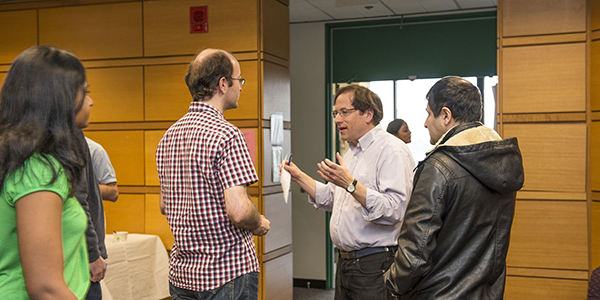 Image may be NSFW.
Image may be NSFW.Clik here to view.
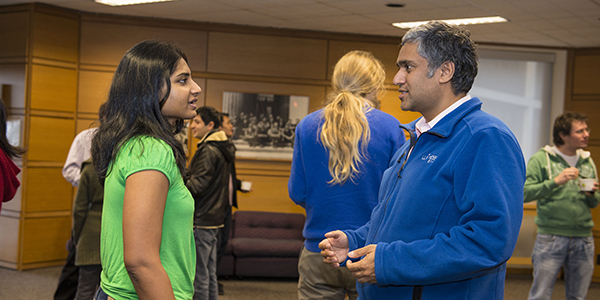 Image may be NSFW.
Image may be NSFW.Clik here to view.
 Image may be NSFW.
Image may be NSFW.Clik here to view.
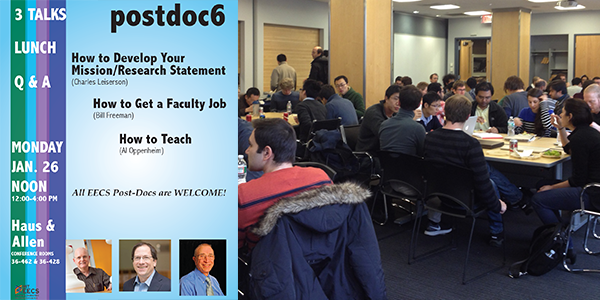 Image may be NSFW.
Image may be NSFW.Clik here to view.
 Image may be NSFW.
Image may be NSFW.Clik here to view.
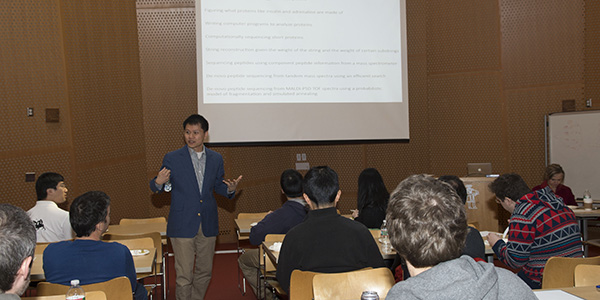
“So you are in! [as a postdoctoral associate in EECS at MIT] What is important about your research that matters in applying for a job? Is there funding? Is your [research] area one that has traction in getting funding?”
Professor Munther Dahleh, spoke extemporaneously to an overflow crowd of over 100 postdocs who came to the first fall event held in late October 2014 for Postdoc6, a group, which was created by the Electrical Engineering and Computer Science (EECS) Department in late 2013. Dahleh, the Director of MIT’s Engineering Systems Division and the William A. Coolidge Professor in electrical engineering and computer science is talking with the group to encourage open discussion about the issues that these researchers face as they seek to establish their paths in either academic research or research positions in industry. He guided the responsive group towards his main point: “Ownership — own your piece of work. Show that you can think for yourself.”
Dilip Krishnan, a former postdoc since fall 2013, worked with Professor Bill Freeman in the field of computer vision to develop depth perception. When he graduated from NYU, he didn’t know whether he wanted to head for an academic or industry research position, so building his research independence as a postdoc was his most important next step. “In a PhD,” he said, “things are driven by the vision of your advisor rather than your own. A postdoc gives you much more freedom to set your own agenda but you need to take advantage of that opportunity,” Krishnan notes. He is now a research scientist at Google Cambridge.
At MIT, as of fall 2014 there are 1,565 postdoctoral associates and in the EECS Department roughly 240 postdocs working in the four affiliate labs — Computer Science and Artificial Intelligence (CSAIL), Laboratory for Information and Decision Systems (LIDS), Microsystems Technology Laboratories (MTL) and Research Laboratory of Electronics (RLE). Besides being spread across these four labs housed in buildings 39, 38, 36 and 32, the population of EECS postdocs pales in comparison with roughly 800 undergraduates and 750 graduate students. The ultimate effect is that EECS postdocs, who are already steeped in heavy demands for original research and leadership in their fields — usually in a short time span — are likely to become isolated, missing potential opportunities for networking that could make a difference as they reach for their next, or ultimate career goal.
Recognizing these realities and at the suggestion of the 2013 EECS Visiting Committee, the leadership in EECS decided to start a new group — now called Postdoc6 — to give its postdoctoral associates a sense of community and to address concerns and needs. After an initial gathering in late fall 2013 to test the interest, EECS department head Anantha Chandrakasan and then associate head Bill Freeman launched the group with a daylong workshop “A Bootcamp for EECS Postdocs.” The attendance was strong and feedback clearly showed that the variety of talks and participatory aspects of the class were useful and appreciated.
Freeman continued to establish the new EECS postdoc group organizing three other events in spring 2014 to answer the needs typical for postdocs: networking, understanding funding avenues, starting a teaching or industry career and learning from recent graduates who were interviewing for faculty positions. He noted: “Being a post-doc is the ideal job. You usually have the freedom to explore whatever you want to, and you're often in a very supportive work environment. You generally have the freedom to try something new, and the freedom to fail without bad consequences happening.”
Time to gain perspective
Former CSAIL postdoc I-Ting Angelina Lee, who earned SM and PhD degrees in computer science from MIT, found her experience valuable in the long run, though she says that the transitional (and temporary) nature of the position created anxiety for her. Deciding between an industry position and an academic one was difficult. Having taught 6.172 alongside Prof. Charles Leiserson, Lee found that she gained perspective on the role of a principal investigator (pi) and professor. “ I got to see different perspectives from the point of view of a pi but not total head of household— if the house comes crashing down, Charles would be there,” she noted last summer (2014). She is now an assistant professor at Washington University in St. Louis.
Networking with other postdocs and graduate students is very helpful
Gunjan Agarwal a former postdoc in Prof. Dana Weinstein’s group in the Microsystems Technology Laboratories, MTL, was very enthusiastic about Postdoc6 and hoped for even more events and opportunities for postdocs to interact. As a Course 2, MIT MechE PhD graduate, Agarwal noted about postdocs in general, “Interaction with other postdocs is important — you are on a different curve than a graduate student. As a postdoc, different possibilities open up — it's a big choice. While I was a grad student, I would interact with other students even though we were not doing the same thing — on a broad perspective.” While still a postdoc Agarwal noted that just as EECS graduate students meet for coffee hours, it would be beneficial for a similar, regular event that could be organized by and for postdocs in the department. She also suggested establishing an online portal site for postdocs to be privately listed with the potential to exchange resource ideas and encourage greater mutual support.
Balancing act: the two-body problem
When Daniel Zoran graduated from Hebrew University and joined Prof. Freeman’s lab to work in computer vision, he had been well prepared as a graduate student for his postdoc position and preferred to work at MIT. “I came here to expand my horizons. I hope to become faculty at some point. I chose MIT because it’s very densely populated in a good way.”
Zoran’s wife, a neuro biologist was also looking for a postdoc position. They were unusually fortunate to be able to choose between three offers. His wife took a postdoc position in MIT’s Brain and Cognitive Sciences and expects to stay on for three years. “My wife does real experiments where everything is very time-consuming,” he notes. “With a two-year-old son, very little free time is left. The bottom line is that you need to publish something during this span of time.” Zoran plans to continue research in Cambridge while his wife finishes another year of her postdoc at MIT.
Postdoc positions in Engineering — early preparation
Ram Vasudevan, former postdoc with Prof. Russ Tedrake in CSAIL and now an assistant professor at the University of Michigan, came to MIT after earning his PhD at UC Berkeley. After attending several of the Postdoc6 events in spring 2014, he wishes he had had this kind of preparation while he was a graduate student. In reflection, he says “I like how you guys are now turning it [Postdoc6] into something that is not only for postdocs but for senior graduate students. That is a smart idea. Many places are just beginning to start up similar initiatives in engineering now.”
Having searched for a long time for the most advantageous postdoc position, Vasudevan found that the academic landscape in engineering — in terms of sequence of study followed by postdoc positions — is beginning to resemble that in biology. “That is,” he notes, “the postdoc is starting to become a standard component of any individual interested in pursuing an academic career.”
Broad vision in a defined field
Zheshan Zhang has been a postdoc for three years — working as an experimentalist in quantum optics in RLE. Working with theorist Prof. Jeff Shapiro and experimentalist Franco Wang is an experience that Zhang both enjoys and finds very helpful in his personal development. Quantum optics as a field is in its early stages, but Zhang is hopeful for opportunities as some companies such as Google and IBM have begun to set up labs in this developing field.
Raised in China, where he completed his undergraduate work, Zhang was a graduate student at Georgia Tech in both the US and Georgia Tech’s European campus in France. He notes, “I have lived in 3 different continents. This is a benefit.” With multinational contacts, Zhang hopes to continue to give research talks abroad to make his work known — while he explores both academia and industry.
As the EECS department leadership has shaped the structuring of Postdoc6 to respond to feedback from its postdocs, several participants have voiced appreciation and suggestions for building what is already a responsive community. In addition to making data on postdoc positions available to its current graduate students, EECS postdocs have voiced the need for establishing a database on the job scene — for both academic and industry positions. Several have suggested a career fair for postdocs and the need for local opportunities for coffee hours and networking.
Postdoc 6 — full cycle
By January 2015 launching into its second year, Postdoc6 held another all-day workshop. “With many new postdocs every year, we should allow for this repeat,” said the new coordinator for Postdoc6 Aude Oliva, Principal Research Scientist in CSAIL and the MIT Computer Vision and Graphics Group. “Now we have the full cycle,” she notes, “… and continuity is underway.”
Oliva should know about postdocs. She held four different postdoc positions in four different countries, in four different research areas over the course of seven years. “Those are the golden years of building your mind!” she notes enthusiastically about the postdoc experience. In fact, Oliva, formerly an associate professor in the MIT Department of Brain and Cognitive Sciences, used to run workshops for graduate students about postdocs and future advising. “I am a big fan of the future,” she says. “When you are neither a student or a faculty,” she notes, “you can open your mind up and dedicate most of your time to develop a research program that will make you unique.”
Now almost two years in CSAIL and EECS, Oliva finds that the cross-disciplinary nature of these communities allows for the best opportunities for exchange “…where one of my students in neuroscience, for example, can talk with an expert in robotics,” she says. She also notes that larger talks and events offered by Big Data and Start6 are also geared to postdocs.
Based on the attendance (over 70) at the January 26 workshop, Oliva says that the feedback suggested concrete views, such as how the search process happens behind the scenes, and personal perspectives such as developing an effective research statement, were elements most highly appreciated. Professor Charles Leiserson led a session for participants to develop a unique research statement in two sentences. “Learning how to make such an impactful statement was so useful!” Oliva said. She was glad to have been present herself.
News Image:
Clik here to view.
